Robusta coffee prices at 28-year high
In May, world coffee prices monitored and compiled by the ICO (I-CIP) decreased slightly by 1.7% compared to the previous month to an average of 175.5 US cents/pound, corresponding to 170 - 179.2 US cents/pound.
However, coffee prices remain firm, supported by declining exports and lower production than consumption demand in two consecutive crop years (2021-2022 and 2022-2023).
The average price of all coffee groups decreased in May, except for Robusta, which increased by 5.9% to an average of 122.5 US cents/lb. This is the highest price for Robusta coffee in the past 28 years, since the price of 130.2 US cents/lb reached in August 1995. In the first week of June, Robusta coffee prices even climbed to more than 134 US cents/lb.
In contrast, prices for Colombian Arabica and Other Arabica fell 3.4% and 4.1%, respectively, to an average of 226.9 - 220.1 US cents/pound. Prices for Brazilian Arabica also fell 4.3% to 186.8 US cents/pound.
Price developments of coffee groups from 2021 - 2023
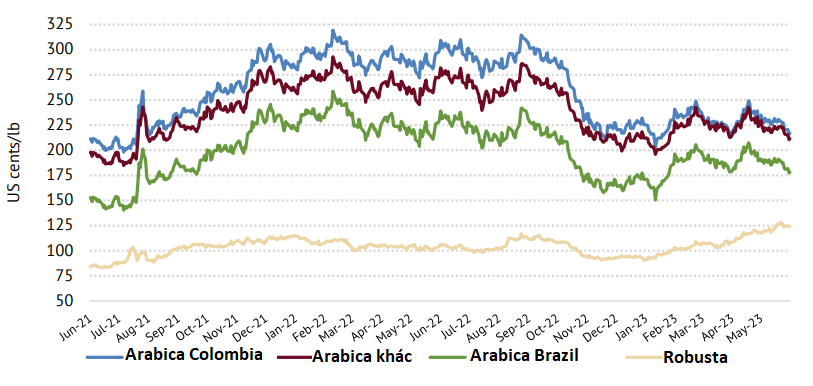
(Source: ICO)
On the New York floor, the price of arabica for May fell 2.2% to 183.1 US cents/pound; while the price of robusta on the London futures market increased 6.8% to 112.6 US cents/pound. The price difference between robusta and arabica coffee on the two floors decreased by 13.8% to 70.6 US cents/pound.
The price gap between robusta and arabica coffee has narrowed significantly since mid-2022. This is due to the relatively rapid growth of robusta coffee, while arabica coffee has continuously decreased in the fourth quarter of 2022 and reached a low level in early 2023.
Since mid-April, robusta coffee prices have separated from other coffee groups, helping to accelerate the process of narrowing prices between robusta and arabica coffee. Currently, the price difference between these two types of coffee is at its lowest level since the first and second quarters of 2021.
The latest survey shows that as of June 10, the price of robusta coffee for July delivery on the New York floor has reached a record of 2,728 USD/ton, up 46% compared to the beginning of this year.
Arabica coffee prices also increased but with a lower amplitude, up about 19 - 20% compared to the beginning of the year, reaching 190.7 US cents/pound for near term.
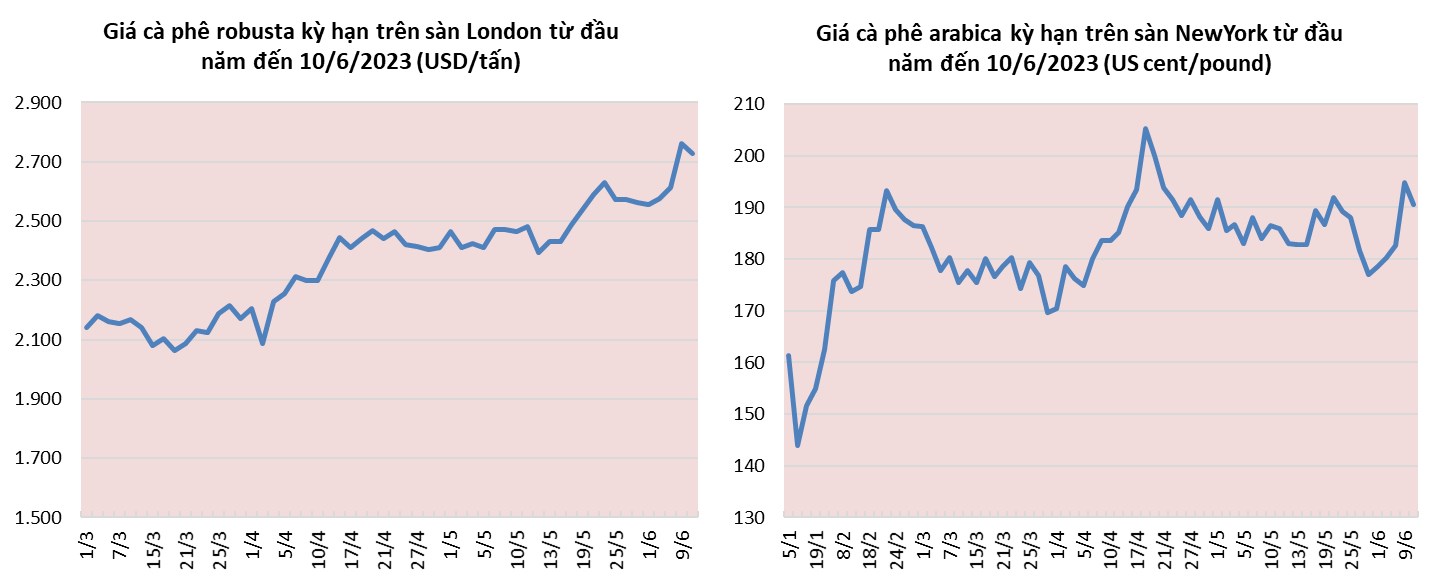
Hoang Hiep synthesis
Demand increases sharply while supply decreases
The ICO said robusta prices have benefited from market fundamentals, particularly demand. Over the past 12 months (March 2022 to April 2023), robusta green coffee exports fell by just 0.3% while arabica exports fell by 6.8%.
This mixed movement reflects a shift in instant coffee blends from arabica to robusta due to rising living costs.
Inflation has been rising sharply in most economies around the world. The Eurozone’s Harmonized Consumer Price Index (HICP) rose to an average of 8.8% in the March 2022-April 2023 period from 4.4% a year earlier (March 2021-April 2022), making goods more expensive.
Inflation has been accompanied by interest rate hikes. The US Federal Reserve (Fed) raised its benchmark interest rate to 5-5.25% in May 2023 from near zero in March 2022. Similarly, the European Central Bank (ECB) raised its benchmark interest rate to 3.75% in May 2023 from 0.5% in July 2022, boosting consumer spending on loans and mortgages.
Since mid-April, robusta coffee prices have also been strongly supported by supply, mainly due to concerns about supply in leading producing countries such as Vietnam, Brazil and Indonesia.
The US Department of Agriculture (USDA) estimates that Vietnam's coffee output in the 2022-23 crop year will decrease by 6% compared to the previous crop year, to 29.7 million bags (60 kg/bag). The world's largest robusta producer will have its lowest harvest in four years due to higher production costs (labor, fertilizer) and farmers tending to switch to more profitable crops such as avocado, durian and passion fruit.
It will not be until the 2023-2024 crop year that Vietnam's coffee output can recover 5% to 31.3 million bags, according to USDA's assessment.
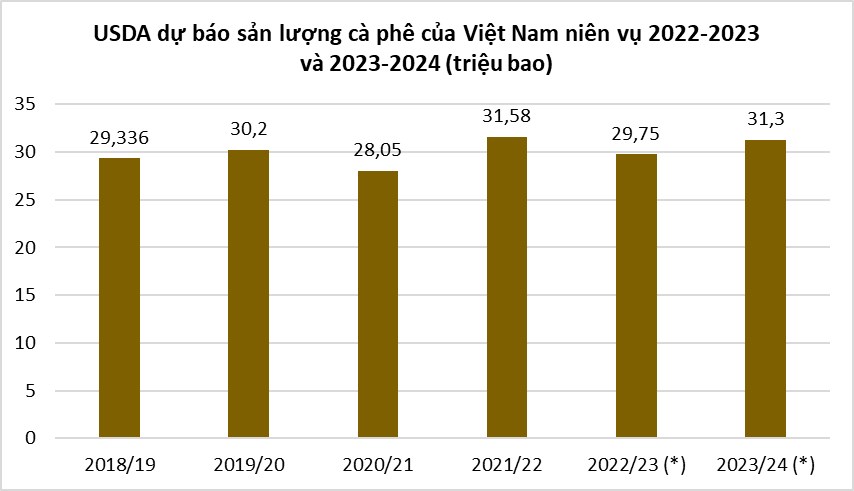
Source: Hoang Hiep compiled from USDA
The Vietnam Coffee and Cocoa Association (VICOFA) previously estimated that Vietnam's robusta coffee output in the 2022-2023 crop year would decrease by 10-15% compared to the previous crop year to about 1.5 million tons due to the impact of unfavorable weather and the wave of crop shifting to fruit trees, especially durian, avocado and passion fruit.
With production down 10-15%, exporters are concerned that there will not be enough coffee to deliver in the second half of the year. In mid-May, it was reported that about 90% of Vietnam’s current crop had been sold.
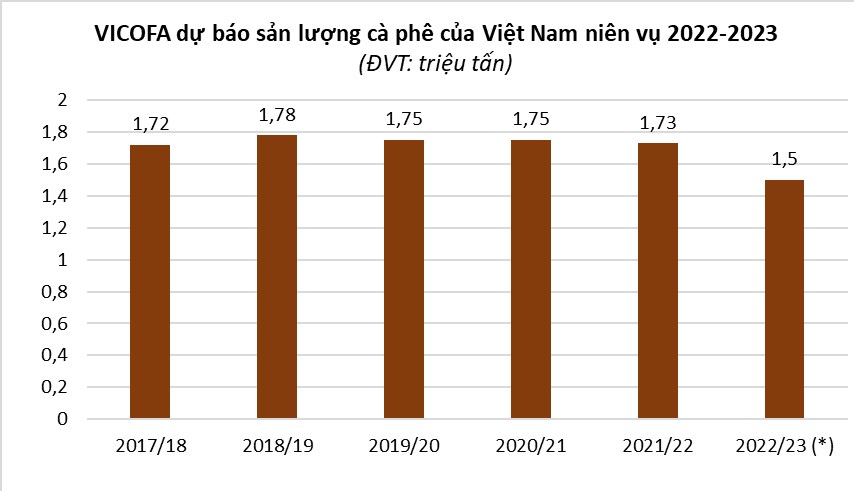
Source: Hoang Hiep compiled from VICOFA
Meanwhile, supplies from Brazil, the second-largest producer of robusta, were significantly lower, with exports reaching 0.4 million bags in the first four months of 2023 compared to nearly 0.5 million bags in the same period in 2022 and 1.24 million bags previously.
USDA forecasts Brazil’s robusta coffee production in 2023-24 (July 2023 to June 2024) to reach only 21.7 million bags, down 5% from 2022-23. This is due to lower yields and poor weather conditions due to lower rainfall in the early stages of the crop cycle.
Meanwhile, in Indonesia, the Association of Indonesian Coffee Producers and Exporters (AEKI) expects the country’s coffee output to fall by up to 20% in 2023 compared to the previous season, to 9.6 million bags due to heavy rains in major growing areas. Indonesia is currently the world’s third-largest producer of robusta coffee.
In addition, the El Nino weather phenomenon, which is expected to develop globally in the second half of this year, also poses a greater risk to robusta than arabica. This weather phenomenon will disrupt rainfall and temperature patterns, which could further tighten supplies and increase robusta prices.
The world's two largest robusta coffee producers, Vietnam and Brazil, could suffer yield losses if El Nino develops strongly, analysts and weather experts say.
According to ICO's forecast, the global coffee supply in the 2022-2023 crop year is around 171.3 million bags while consumption is at 178.5 million bags, with this forecast the world coffee market could have a deficit of 7.3 million bags in the current crop year.
Notably, in the 2022-2023 crop year, global Arabica coffee production is expected to increase by 4.6% to 98.6 million bags. Meanwhile, Robusta production is expected to decrease by 2.1% to 72.7 million bags.
All of the above factors have led to an increase in certified robusta coffee stocks on the London ICE exchange.
As of the end of May, certified robusta coffee stocks on the London exchange were 1.4 million bags (60 kg), up 5.9% from the previous month. In contrast, arabica stocks on the New York exchange fell 11.2% to 0.66 million bags.
Coffee reserves on the New York and London exchanges until May 2023
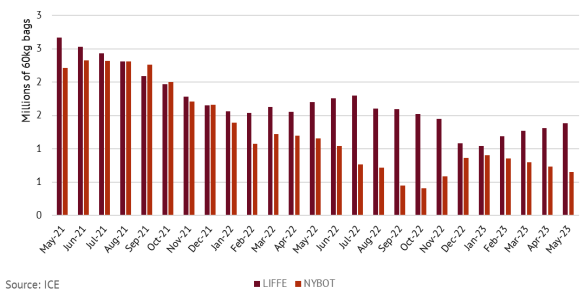
(Source: ICO)
Source


































































































Comment (0)